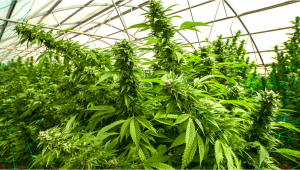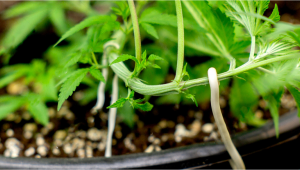7 Top Tips On Supporting Heavy Buds Indoors (2023)

- 1. Bamboo canes
- 2. Scrog
- 3. Tying up branches
- 4. The trellis
- 5. Airflow and humidity
- 6. Building tomato cages
- 7. Yo yo devices
- 8. Extra tips
- 9. In conclusion
Every plants grower dreams of big buds when they sow their plants seeds into the soil. Why? Because big buds simply look better. They’re much more impressive when you rock up to a smoking session with friends; they put your horticultural skills on display! Plus, larger buds possess more frosts. These small chemical factories are the powerhouse glands of plants plants that produce all of the valuable strength and flavor. Because bigger buds have a greater surface area, they are able to produce more of these structures (although genetics also plays an important role when it comes to frost density).
However, there’s always the risk of receiving too much of a good thing. While big buds are more impressive and packed with phytochemicals, they can grow to a point where they become a structural issue. If buds grow in weight beyond the capacity of branches, they can cause them to bend and even damage branch tissue. Adding support to your Plants plants during the flowering period has many advantages. Not only does it allow the plants to concentrate on producing fat and dense buds, but it also prevents buds from falling over. In this article, we cover 7 top tips for adding support to your plants when they need it the most.
1. Bamboo Canes
An old-school, inexpensive and great way to add extra support for your plants. Sourcing bamboo cane is cheap, easy to sterilize and clean, and will last for a long time if treated well. Canes can be used early on during the growth stage to tie young plants. Bamboo canes are also a tried and tested technique when it comes to supporting branches. You can walk into any vegetable growers' garden and find these stakes supporting massive tomatoes, cucumbers, and even squashes and melons. Although they may not seem like much, these pieces of kit do a great job of supporting main stems and branches and preventing large buds from inflicting damage.

Our top tip here is to add bamboo canes that are the same height as the plants, then insert them on the outer part of the pots. Imagine inserting the canes on the outside like the numbers on a clock, and creating a circle that can be used to tie the side branches to the bamboo. Do not insert the bamboo into the center of the growing medium as this will penetrate the roots and cause stress.
Bamboo canes also come in handy outdoors when growing plants in raised beds or directly in the ground. Here, you should select canes that are taller than the plant itself. This will allow you to drive a large portion of the cane into the soil and create a very secure base. This will help prevent buds from snapping branches and also protect your plants during periods of high winds.
2. SCROG
Screen of Green setups is an incredible way to train plants during the vegetative period of 18/6 and then allow them to grow with a solid, hardwood, and thick structure. Most times the net, wire, or trellis that has been used will be made of a lightweight material not really designed to support the weight of the buds.

Our top tip here is to use the SCROG method to grow mature and well-established thick branches. Once the plants are grown, the net or screen could effectively be moved, as it is only used as a guideline for canopy control and manipulating the growth structure and distribution of energy.
3. Tying Up Branches
Tying side branches and main central colas to adequate support sounds simple enough, however, there are a few things that a beginner grower should consider. Over time the thickness of the branches will expand and may even double in size.

Our top tip here is to avoid using anything such as plastic cable ties or metal wire and choose to use twine or elastic. The reason being plastic and wire ties can cut through the wooden branches as they expand, oftentimes decapitating the branch slowly. Using elastic or twine will give you much more leverage and in an emergency can be cut away easily.
4. The Trellis
It is important not to get confused with a Screen of Green setup and a trellis net. One is designed to be used as a guide during 18/6, in combination with advanced plant training. The other is to be used as a support net later on during the blooming period.

Our top tip here is to use a net trellis that can be easily installed inside of the grow tent, or over a large outdoor plant. The size of the squares in the net will easily fit over your flowering plants and will provide leverage also during heavy winds, and when the weight of the buds causes the plants to topple over. As opposed to bamboo canes, a trellis surrounds the entire plant from all directions.
This offers a superior level of support and prevents large buds from dragging plants in one particular direction. The individual squares of a trellis also offer many more places to tie up your plants. The trellis itself acts as a support structure, but you can also tie branches to particular sections, or feed branches through squares that will prevent branches from sagging under the weight of buds.
5. Airflow and Humidity
If you have had the pleasure of growing plants both in and outdoors, you will have probably already realized that outdoor plants are usually a little more robust than our indoor princesses. This is thanks to nature’s harshness - the wind and rain lashing them about, and the full spectrum of our star’s sunshine beaming down on them every day produce strong pot trees that can for the most part handle the heavy burden on bulbous buds. These conditions can be reproduced to a certain extent with indoor grows by using the correct lighting for your grow area, and by making sure the air is circulating in the correct fashion. By adding some oscillating fans at the canopy level, the plants will not only benefit from the better air exchange, but also by being blown about they will become tougher and more fibrous.
By providing the correct temperature and humidity levels, you will help your plants grow into the healthiest specimens possible. These ranges fluctuate slightly throughout the life cycle, but a good general range for healthy plants growth is 20 - 25C (70 - 80F) with a relative humidity level of 40 to 60 percent.

If the goal is to grow buds so big they need support, then it is essential that the airflow and humidity around the tops and bottoms of the buds are ideal. There is nothing worse than finding out that your dense, frosty buds have become so thick they are molding from the inside out due to Botrytis. Our top tip here is to keep the humidity as close to 30-35% as possible and to encourage a free-flowing current of fresh air. Make sure that the lower points of the plant are receiving lots of fresh air also, and there is well-balanced airflow around the tops and bottom of the canopy. In the event that you notice some buds have a gray, candy floss appearance and when touching feel like a spider web, you should cut this part of the plant away immediately to prevent further contamination.
6. Building Tomato Cages
A great extension to bamboo supports and a way to box your Plants plants in with maximum support, building a frame by tying bamboo canes horizontally to existing bamboo works a treat. There are many benefits associated with customizing the sections to the frame and allowing the side branches to grow out at an angle where they will receive the most light.

Our top tip here is to add the bamboo in horizontal positions that will encourage the side branches to grow outwards. Tying the side branches vertically still works fine, however, the growth structure and appearance will be much improved and the amount of direct light the inner branches receive is increased. This is one-way outdoor farmers in California grow such enormous-sized plants.
7. Yo Yo Devices
These small but highly effective devices are designed to be hung directly above your plants, and attached to the designated branches. Over time the amount of leverage is increased to raise the branches to a set height. The benefits associated with using yo-yos are that thanks to their small size, it is easy to attach up to 10 of these devices per plant.

Our top tip here is to use these to keep heavy side branches from falling onto other buds. As the plants begin to flower heavily, the canopy will become very crowded, so using yo-yos for each individual branch is a wonderful way to prevent buds from touching one another or the sides of the grow tent. Buds will begin to mold and spread if allowed to touch wet walls or begin to lean on other branches.
8. Extra Tips
This may seem like stating the absolute obvious, but feeding your plants with correct amounts of nutrients will go a long way to building the strongest plants possible - as will using top-quality fertilizing products and additives, and the best possible growing medium. For plant strength, in particular, you want to make sure you are offering your ladies the right amounts of calcium, potassium, and phosphorus. But, keep in mind that it is highly important to feed the correct full range of macro and micro-nutrients. Overfeeding one nutrient will have the opposite effect you are looking for.
A high-quality growing medium will not only help with plant stability by offering a firm footing for the roots but will also help with the nutrient transfer from medium to root. Here at FastBuds, we prefer to use top-notch coco-coir as our main growing medium, as it offers many of the benefits of both soil and hydro growing, and is very beginner-friendly. Always do your research before settling on any medium, nutrient mix, or additive. These days, the market is flooded with options - and not all of them are worthy of your hard-earned cheddar. Some reputable companies that we recommend checking out are House and Garden, Canna, Advanced Nutrients, General Hydroponic, Fox Farm, Bontanicare, and Technaflora among others. If ever in doubt, head over to your local hydro store and see what they have in stock and what they recommend.
9. In Conclusion
There are many ways to help support Plants plants when they are focusing on blooming have many advantages. Usually, auto plants grow compact and do not always need support depending on the seed. If you're growing our Orange Sherbet Auto be sure to prepare bamboo canes to support her super heavy buds and try tying her down to control the height.
This beast can grow up to 150cm and in optimum conditions can give you 500-650gr/m2 easily. One of the most important things to consider is not letting the buds touch one another and keeping the airflow and humidity of the garden in the pathogen-free safe zone. Good luck growing monster plants that need all the support they can get.







Comments